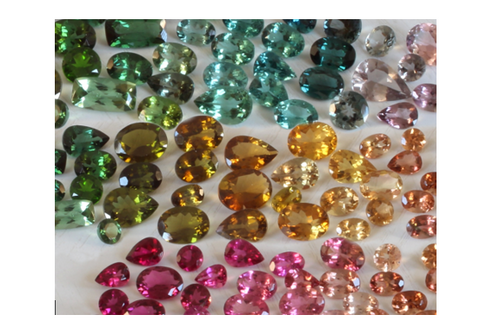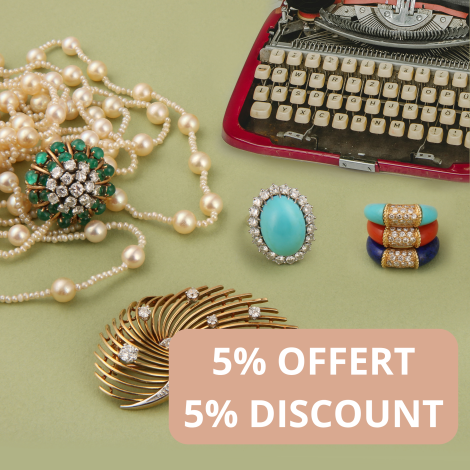Tourmaline: The Stone With Infinite Colors

Tourmaline comes from the Sinhalese “turamali”, which means “multi-coloured stones”.
History :
Tourmaline has been mined for centuries in Asia, but was only properly introduced to Europe in the 17th century by the Dutch East India Company. A multi-colored curiosity stone, it was originally used for its physical properties. Indeed, tourmaline has the particularity of developing static electricity through pressure or heat, known as piezoelectricity and pyroelectricity. During mining prospecting, the presence of tourmaline in the ground can be a geological clue to the presence of gold veins.
Because of its multiple colors, tourmaline was long confused with other gemstones such as emerald and ruby, and was only identified as a family of stones in the 18th century.

Thus the “Rubis de César”, at the time considered the largest ruby in Europe, a gift from King Gustav III of Sweden to Empress Catherine the Great of Russia to celebrate her 15-year reign, was in fact a Rubellite (red tourmaline)...
Color :
Tourmaline has a very wide chromatic range, and can even be the result of an assemblage of two or three colors. Raw crystals of this stone are rarely one and the same color, and there are also crystals with one color on the inside and another on the outside.

Tourmaline color range
The tourmalines most commonly found in jewelry are :
- Rubellites, pink/red tourmalines, often with a hint of violet or brown, which may have been confused with rubies, whose linguistic origin comes from the Latin “Rubellus” for “reddish”. A deep red specimen is preferable to one with shades of brown. This variety has long been the most expensive.

- Verdelites, from yellow-green to bottle-green, dark green or olive.

- Paraiba tourmalines has a very bright blue color due to copper sulfate. It is the most recently discovered and most expensive variety of tourmaline. The first deposit was discovered in 1989, in the Brazilian state of Paraíba, giving it its name. Today, this first deposit is exhausted, but new ones have been found: in Nigeria in 2001 and in Mozambique in 2005. Stones from these African mines have been legally sold under the Paraíba name since 2006.

- Indigolites are light blue to bluish-green in color and are sometimes referred to as “Tourmaline-Emerald”, as the colors of these two stones can be very close.

- Polychromatic tourmalines, such as “melon d'eau”, combine a pink interior with a green periphery, hence its name. Because of the particular distribution of its color, it can often be sliced to display its different shades.

Where is tourmaline found?
Tourmaline is a stone found all over the world. From Africa to Asia via Russia, America and even Europe. But its main deposits are in Brazil and Sri Lanka.
It was in 1989 that the Paraiba tourmaline was discovered by Brazilian miners. Never had such a stone been seen before. Today this tourmaline is the rarest and most sought after and therefore the most expensive.
After the Second World War, German immigration was considerable in the State of Minas Gerais in Brazil, where very important mines were discovered. These immigrants forged close ties with Idar Oberstein. This small German town has become the main cutting center for the production of the Cruzeiro, Golconda, Virgem da Lapa and Itatiaia (Jonas) mines.
A few high jewelry pieces in tourmaline

Necklace chopard tourmaline paraiba diamonds 18 carat white gold

Earrings Chaumet tourmaline indicolite collection ondulations

Polar Bear Clip Van Cleef & Arpels, White gold, round diamonds, onyx, round sapphires and round, oval and cushion blue tourmalines, Les Voyages Extraordinaires Collection

Ring Jasmine Van Cleef & Arpels, White gold, one oval green tourmaline of 39.30 carats, spessartite garnets, pink spinels, onyx, diamonds, Collection Les Audacieuses

Sentimenti Van Cleef & Arpels ring, Rose gold, yellow gold, 6.63 carat oval pink tourmaline, rubies, spessartite garnets, coral, white cultured pearls, diamonds, Romeo & Juliet Collection
If you are interested in tourmaline, do not hesitate to discover what Les Pierres de Julie offers in store…
We are also available for any free expertise of your tourmaline jewelry, for this you can send an email with your photos to contact@lespierresdejulie.com.
Whether you're interested in buying a piece of jewellery or a stone, a free jewelry appraisal or jewelry resale, Pierres de Julie welcomes you to its Parisian boutique in the Village Suisse, a stone's throw from the Ecole Militaire and the Esplanade des Invalides.











